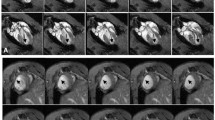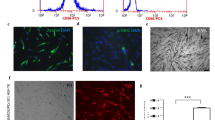Abstract
Purpose
The purpose of the study is to track iron-oxide nanoparticle-labelled adult rat bone marrow-derived stem cells (IO-rBMSCs) by magnetic resonance imaging (MRI) and determine their effect in host cardiac tissue using 2-deoxy-2-[F-18]fluoro-d-glucose-positron emission tomography (FDG-PET).
Procedures
Infarcted rats were randomised to receive (1) live IO-rBMSCs by direct local injection, or (2) dead IO-rBMSCs as controls; (3) sham-operated rats received live IO-rBMSCs. The rats were then imaged from 2 days to 6 weeks post-cell implantation using both MRI at 9.4T and FDG-PET.
Results
Implanted IO-rBMSCs were visible in the heart by MRI for the duration of the study. Histological analysis confirmed that the implanted IO-rBMSCs were present for up to 6 weeks post-implantation. At 1 week post-IO-rBMSC transplantation, PET studies demonstrated an increase in FDG uptake in infarcted regions implanted with live IO-rBMSC compared to controls.
Conclusions
Noninvasive multimodality imaging allowed us to visualise IO-rBMSCs and establish their affect on cardiac function in a rat model of myocardial infarction (MI).





Similar content being viewed by others
References
Orlic D, Kajstura J, Chimenti S et al (2001) Bone marrow cells regenerate infarcted myocardium. Nature 410:701–705
Tse HF, Kwong YL, Chan JK et al (2003) Angiogenesis in ischaemic myocardium by intramyocardial autologous bone marrow mononuclear cell implantation. Lancet 361:47–49
Perin EC, Dohmann HF, Borojevic R et al (2003) Transendocardial, autologous bone marrow cell transplantation for severe, chronic ischemic heart failure. Circulation 107:2294–2302
Stamm C, Westphal B, Kleine HD et al (2003) Autologous bone-marrow stem-cell transplantation for myocardial regeneration. Lancet 361:45–46
Strauer BE, Brehm M, Zeus T et al (2002) Repair of infarcted myocardium by autologous intracoronary mononuclear bone marrow cell transplantation in humans. Circulation 106:1913–1918
Reffelmann T, Kloner RA (2003) Cellular cardiomyoplasty–cardiomyocytes, skeletal myoblasts, or stem cells for regenerating myocardium and treatment of heart failure? Cardiovasc Res 58:358–368
Kraitchman DL, Tatsumi M, Gilson WD et al (2005) Dynamic imaging of allogeneic mesenchymal stem cells trafficking to myocardial infarction. Circulation 112:1451–1461
Hill JM, Dick AJ, Raman VK et al (2003) Serial cardiac magnetic resonance imaging of injected mesenchymal stem cells. Circulation 108:1009–1014
Stuckey DJ, Carr CA, Martin-Rendon E et al (2006) Iron particles for noninvasive monitoring of bone marrow stromal cell engraftment into, and isolation of viable engrafted donor cells from, the heart. Stem Cells 24:1968–1975
Tossios P, Muller-Ehmsen J, Schmidt M et al (2006) No evidence of myocardial restoration following transplantation of mononuclear bone marrow cells in coronary bypass grafting surgery patients based upon cardiac SPECT and 18F-PET. BMC Med Imaging 6:7
Depre C, Vanoverschelde JL, Melin JA et al (1995) Structural and metabolic correlates of the reversibility of chronic left ventricular ischemic dysfunction in humans. Am J Physiol 268:H1265–H1275
Pagano D, Townend JN, Parums DV et al (2000) Hibernating myocardium: morphological correlates of inotropic stimulation and glucose uptake. Heart 83:456–461
Camici PG, Dutka DP (2001) Repetitive stunning, hibernation, and heart failure: contribution of PET to establishing a link. Am J Physiol Heart Circ Physiol 280:H929–H936
Knuesel PR, Nanz D, Wyss C et al (2003) Characterization of dysfunctional myocardium by positron emission tomography and magnetic resonance: relation to functional outcome after revascularization. Circulation 108:1095–1100
Pittenger MF, Mackay AM, Beck SC et al (1999) Multilineage potential of adult human mesenchymal stem cells. Science 284:143–147
Josephson L, Tung CH, Moore A et al (1999) High-efficiency intracellular magnetic labeling with novel superparamagnetic-Tat peptide conjugates. Bioconjug Chem 10:186–191
Himes N, Min JY, Lee R et al (2004) In vivo MRI of embryonic stem cells in a mouse model of myocardial infarction. Magn Reson Med 52:1214–1219
Cahill KS, Germain S, Byrne BJ et al (2004) Non-invasive analysis of myoblast transplants in rodent cardiac muscle. Int J Cardiovasc Imaging 20:593–598
Makino S, Fukuda K, Miyoshi S et al (1999) Cardiomyocytes can be generated from marrow stromal cells in vitro. J Clin Invest 103:697–705
Nagaya N, Fujii T, Iwase T et al (2004) Intravenous administration of mesenchymal stem cells improves cardiac function in rats with acute myocardial infarction through angiogenesis and myogenesis. Am J Physiol Heart Circ Physiol 287:H2670–2676
Jaquet K, Krause KT, Denschel J et al (2005) Reduction of myocardial scar size after implantation of mesenchymal stem cells in rats: what is the mechanism? Stem Cells Dev 14:299–309
Amado LC, Saliaris AP, Schuleri KH et al (2005) Cardiac repair with intramyocardial injection of allogeneic mesenchymal stem cells after myocardial infarction. Proc Natl Acad Sci USA 102:11474–11479
Dai W, Hale SL, Martin BJ et al (2005) Allogeneic mesenchymal stem cell transplantation in postinfarcted rat myocardium: short- and long-term effects. Circulation 112:214–223
Tomita S, Li RK, Weisel RD et al (1999) Autologous transplantation of bone marrow cells improves damaged heart function. Circulation 100:II247–II256
Miyahara Y, Nagaya N, Kataoka M et al (2006) Monolayered mesenchymal stem cells repair scarred myocardium after myocardial infarction. Nat Med 12:459–465
Rudd JH, Warburton EA, Fryer TD et al (2002) Imaging atherosclerotic plaque inflammation with [18F]-fluorodeoxyglucose positron emission tomography. Circulation 105:2708–2711
Zhang Z, Machac J, Helft G et al (2006) Non-invasive imaging of atherosclerotic plaque macrophage in a rabbit model with F-18 FDG PET: a histopathological correlation. BMC Nucl Med 6:3
Acknowledgements
The authors would like to thank the Nuclear Medicine Service of Hammersmith Hospital, London UK, for the kind gift of FDG. Thanks to FMRIB at Oxford University for the original pulse sequences.
Conflict of Interest
The authors declare that there is no conflict of interest.
Funding
This work was funded by the Medical Research Council (MRC) of Great Britain. EOA’s laboratory is funded by Cancer Research-UK and MRC.
Author information
Authors and Affiliations
Corresponding author
Rights and permissions
About this article
Cite this article
Chapon, C., Jackson, J.S., Aboagye, E.O. et al. An In Vivo Multimodal Imaging Study Using MRI and PET of Stem Cell Transplantation after Myocardial Infarction in Rats. Mol Imaging Biol 11, 31–38 (2009). https://doi.org/10.1007/s11307-008-0174-z
Received:
Revised:
Accepted:
Published:
Issue Date:
DOI: https://doi.org/10.1007/s11307-008-0174-z




